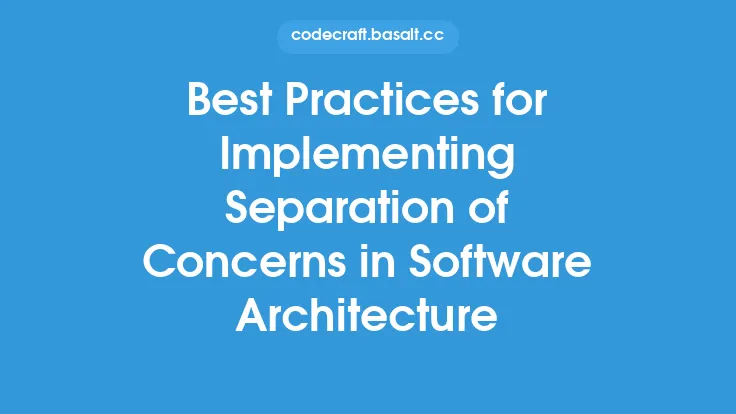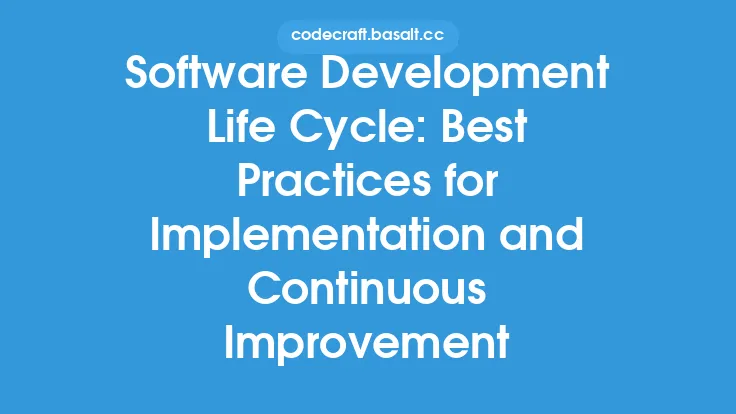Implementing monolithic architecture in software projects can be a straightforward and efficient approach, especially for small to medium-sized applications. However, as the project grows and becomes more complex, the monolithic architecture can become cumbersome and difficult to maintain. To avoid this, it's essential to follow best practices when implementing monolithic architecture. In this article, we'll explore the key considerations and guidelines for implementing monolithic architecture in software projects.
Introduction to Monolithic Architecture Implementation
When implementing monolithic architecture, it's crucial to start with a clear understanding of the project's requirements and goals. This includes defining the functional and non-functional requirements, identifying the target audience, and determining the project's scope. A well-defined project scope will help ensure that the monolithic architecture is suitable for the project and that it can be implemented efficiently. Additionally, it's essential to consider the project's scalability and maintainability requirements, as these can significantly impact the monolithic architecture's effectiveness.
Designing a Monolithic System
Designing a monolithic system requires a thorough understanding of the system's components and their interactions. A monolithic system typically consists of a single, self-contained unit that includes all the necessary components, such as the user interface, business logic, and data storage. When designing a monolithic system, it's essential to consider the following factors:
- Component coupling: Minimize component coupling to ensure that changes to one component do not affect other components.
- Component cohesion: Ensure that each component has a single, well-defined responsibility to maintain a high level of cohesion.
- Data consistency: Ensure that data is consistent across the system by using a single, centralized data storage mechanism.
- Error handling: Implement a robust error handling mechanism to handle errors and exceptions effectively.
Implementing a Monolithic Architecture
Implementing a monolithic architecture requires a structured approach to ensure that the system is built efficiently and effectively. The following steps can be followed:
- Define the system's architecture: Based on the project's requirements and goals, define the system's architecture, including the components and their interactions.
- Design the database: Design a centralized database that can store all the necessary data, ensuring data consistency and integrity.
- Implement the business logic: Implement the business logic, ensuring that it is decoupled from the user interface and data storage components.
- Develop the user interface: Develop a user-friendly interface that interacts with the business logic and data storage components.
- Test and deploy: Test the system thoroughly and deploy it to a production environment.
Testing and Validation
Testing and validation are critical components of the monolithic architecture implementation process. The following testing strategies can be employed:
- Unit testing: Test individual components to ensure that they function correctly.
- Integration testing: Test the interactions between components to ensure that they work together seamlessly.
- System testing: Test the entire system to ensure that it meets the project's requirements and goals.
- Acceptance testing: Test the system with real-world data and scenarios to ensure that it is functional and effective.
Maintenance and Scalability
Maintaining and scaling a monolithic system can be challenging, especially as the system grows and becomes more complex. To ensure that the system remains maintainable and scalable, the following strategies can be employed:
- Refactor code regularly: Refactor code to ensure that it remains modular, efficient, and easy to maintain.
- Implement automated testing: Implement automated testing to ensure that changes to the system do not introduce errors or bugs.
- Use continuous integration and deployment: Use continuous integration and deployment to ensure that changes to the system are deployed quickly and efficiently.
- Monitor system performance: Monitor system performance to identify bottlenecks and areas for improvement.
Security Considerations
Security is a critical consideration when implementing monolithic architecture. The following security strategies can be employed:
- Implement authentication and authorization: Implement authentication and authorization mechanisms to ensure that only authorized users can access the system.
- Use encryption: Use encryption to protect sensitive data, both in transit and at rest.
- Implement access controls: Implement access controls to ensure that users can only access the data and functionality they need.
- Regularly update and patch: Regularly update and patch the system to ensure that it remains secure and up-to-date.
Conclusion
Implementing monolithic architecture in software projects can be an effective approach, especially for small to medium-sized applications. However, it's essential to follow best practices, such as designing a modular system, implementing automated testing, and ensuring security and scalability. By following these guidelines and considering the project's requirements and goals, developers can create efficient, effective, and maintainable monolithic systems that meet the needs of their users.





